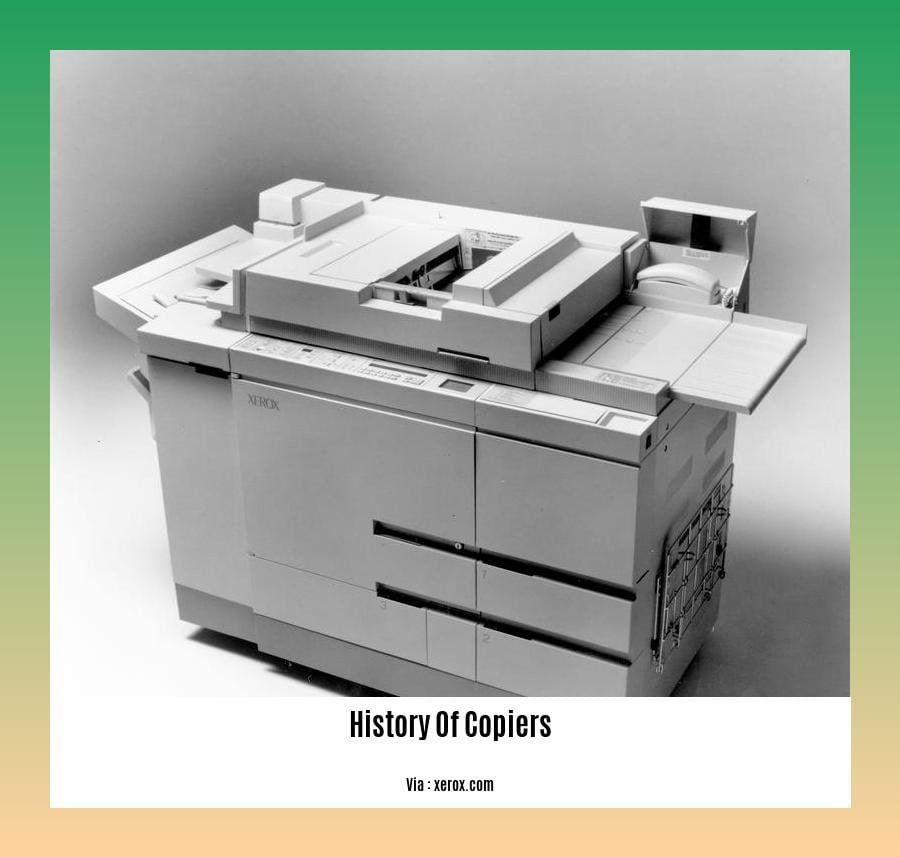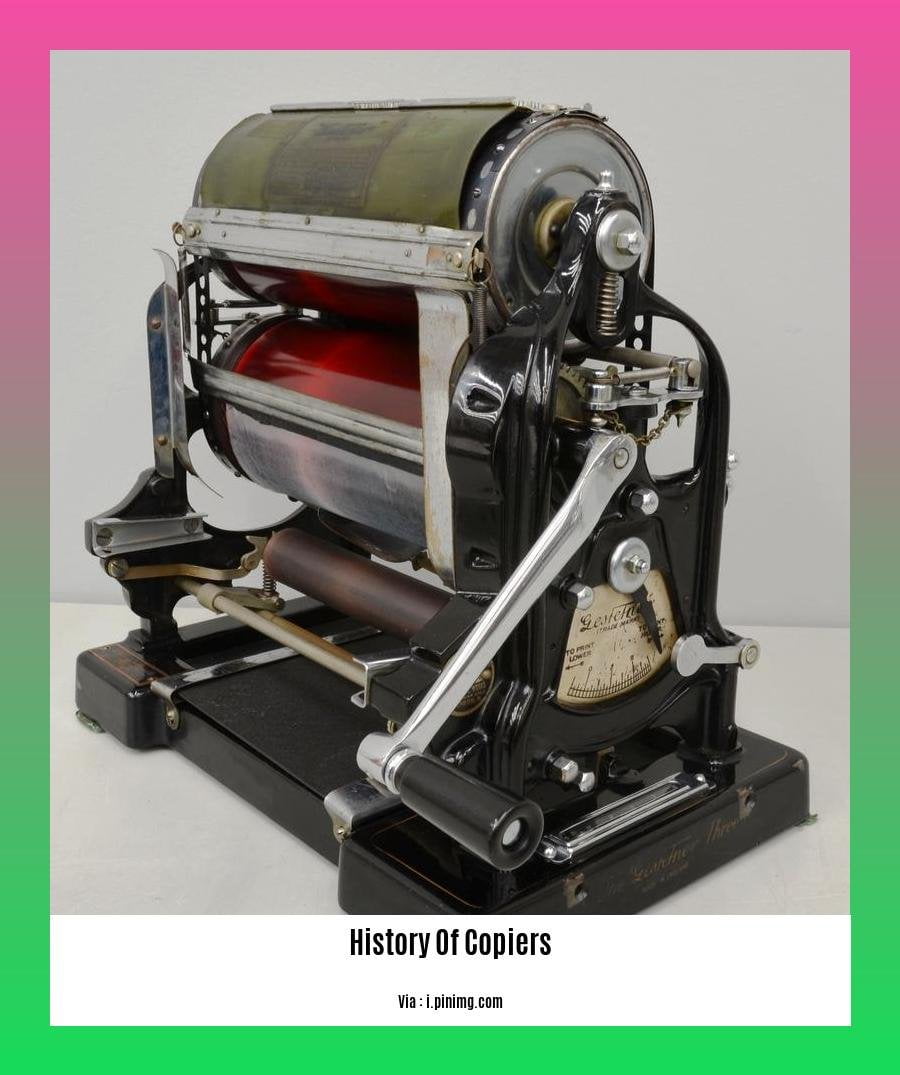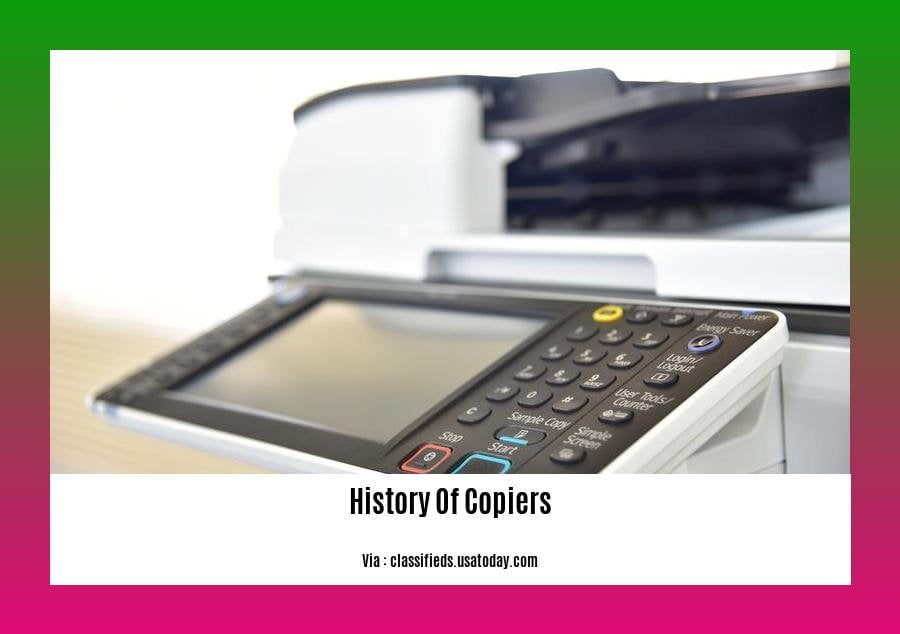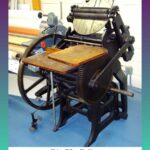In the realm of innovation, the invention of the copier stands as a pivotal milestone, forever transforming the way we replicate information. Join us as we embark on a journey through time, uncovering the captivating history of copiers—from their humble beginnings in ancient civilizations to their evolution into the indispensable office machines we rely on today. In [Unveiling the History of Copiers: From Ancient Origins to Modern Marvels], we’ll explore the ingenuity and perseverance that brought this extraordinary technology to life and examine its profound impact on society, communication, and the world as we know it.
Key Takeaways:
Chester Carlson, a patent attorney with arthritis, invented the photocopier as a part-time researcher and inventor.
Carlson’s initial motivation for inventing the photocopier was to make copies of documents more efficiently in his law practice.
The first modern photocopier machine, the Xerox 914, was introduced in 1959.
The history of the photocopier can be traced through stages such as necessity, research and development, the birth of a photocopier and an industry, cutting-edge technology, and the innovative history of Konica Minolta.
History of Copiers

The history of copiers is a fascinating tale of innovation and technological evolution that has played a significant role in shaping modern communication and office culture.
Necessity as the Mother of Invention
The idea of a machine to replicate documents can be traced back to the 19th century. But it was the struggles of a patent attorney, Chester Carlson, with arthritis that led to the breakthrough. Carlson’s frustration with making copies led him to the idea of using a combination of light and electricity to create an image on paper. He envisioned a machine that could quickly and easily copy documents without the need for stencils or carbon paper.
Research and Development
Carlson spent years refining his idea, experimenting with various materials and techniques. In 1938, he succeeded in creating the first permanent electrostatic image on paper. This breakthrough paved the way for the development of the photocopier.
Birth of a Photocopier and an Industry
In 1959, Carlson’s dream became a reality when the Xerox 914, the first commercial photocopier, was introduced to the market. The Xerox 914 was a revolutionary machine for its time, capable of producing high-quality copies quickly and efficiently. With a price tag of $2,500, it was a significant investment for businesses, but it quickly became an indispensable tool in offices worldwide.
Cutting-Edge Technology
The Xerox 914 was just the beginning. Over the decades, copiers have undergone rapid technological advancements, driven by the integration of new technologies such as lasers, digital imaging, and computer networking.
Innovative History of Konica Minolta
Among the key players in the copier industry, Konica Minolta stands out with a rich and innovative history. Building on the foundations laid by pioneers like Chester Carlson, Konica Minolta has been at the forefront of copier technology, introducing breakthrough products such as the world’s first digital color copier in 1985 and the award-winning bizhub series of multifunction printers.
Today, **the history of copiers** continues to be written as manufacturers push the boundaries of technology, exploring new possibilities in terms of speed, efficiency, and functionality. From the humble beginnings of Carlson’s invention to the sophisticated machines of today, the journey of copiers mirrors the remarkable evolution of technology in our modern world.
Did you know that concrete is one of the oldest and most enduring building materials? Learn the history of concrete timeline and its evolution over centuries.
Unleash the captivating journey of contemporary dance through the ages. Dive into the history of contemporary dance and witness the evolution of movement and expression.
Fascinated by the world of копировальные аппараты? Delve into the intriguing history of copy machines and discover the remarkable innovation that revolutionized the way we reproduce documents.
Xerox Corporation: A Pioneer in the Copying Industry
Who says copying is never a good thing? Not when it comes to Xerox, a name that’s synonymous with simple, fast, and cost-effective replication! Xerox has been in the limelight for years, and rightly so. Let’s rewind to 1959, the year that marked the beginning of a copying revolution.
Xerox unveiled the Xerox 914, a game-changer in the world of copying. This baby was the first commercial photocopier, and it wasn’t just any copier – it was a game-changer. With its ability to spit out high-quality copies on plain paper, it quickly became the darling of offices worldwide.
Xerox didn’t stop there. They kept pushing the boundaries, churning out one innovation after another. Copiers started getting smaller, faster, and even more user-friendly. From analog to digital, the evolution of Xerox copiers has been nothing short of remarkable.
Technological Marvels of Xerox Corporation:
Xerox 914 (1959): The world’s first commercial photocopier, revolutionizing document copying.
Xerox Star (1981): A breakthrough in personal computing, introducing the graphical user interface (GUI) and mouse.
Xerox DocuTech (1991): Pioneering digital printing technology, enabling high-speed, high-volume document production.
Xerox iGen (2002): A game-changer in digital color printing, delivering exceptional image quality and productivity.
Xerox Versant (2010): A versatile digital press, offering advanced features for commercial printing applications.
Xerox is much more than just a copier company. They’re a tech giant that has revolutionized industries and continues to shape the future of work. Their innovations have touched every corner of the business world, making us more efficient, productive, and creative.
Key Takeaways:
- Xerox Corporation pioneered the copier industry with the introduction of the Xerox 914 in 1959.
- Xerox’s innovations in copying technology transformed office culture, enabling fast and economical document reproduction.
- Xerox’s commitment to research and development has led to groundbreaking products, including the Xerox Star, Xerox DocuTech, Xerox iGen, and Xerox Versant.
- Xerox’s impact extends beyond copying, revolutionizing personal computing, digital printing, and commercial printing industries.
Sources:
The Rise of Digital Copying: A Technological Revolution

In a world propelled by the relentless flow of information, the ability to replicate and disseminate knowledge has become a cornerstone of societal progress. From the rudimentary origins of language to the sophisticated marvels of digital technology, the history of copying has been an enthralling journey marked by innovation, ingenuity, and a thirst for knowledge.
A Tale of Bits and Bytes: The Digital Revolution Unfolds
The advent of digital technology ushered in a new era of copying, characterized by unprecedented speed, versatility, and accessibility. In the 1970s, the first digital photocopiers emerged, paving the way for a paradigm shift in the way we replicate documents. These machines harnessed the power of computers to capture and reproduce digital images, eliminating the need for physical intermediates like film or paper masters.
The Xerox 914: A Pioneer in the Realm of Copying Technology
Among the pioneers of this digital revolution was the Xerox 914, introduced in 1959. This groundbreaking machine, the brainchild of Chester Carlson, revolutionized the world of office technology with its ability to produce high-quality, plain-paper copies at remarkable speeds. The Xerox 914 set the stage for the widespread adoption of photocopying technology, transforming the way businesses and organizations communicated and disseminated information.
Beyond Paper: Embracing a Multitude of Formats
The rise of digital copying extended beyond traditional paper documents. The advent of digital audio and video formats opened up new frontiers for replication, enabling the mass distribution of music, movies, and other multimedia content. The introduction of the compact disc (CD) in the 1980s and the subsequent rise of the DVD and Blu-ray formats exemplified this trend, allowing for the storage and playback of high-quality digital media.
The Internet: A Catalyst for Global Connectivity and Sharing
The emergence of the internet in the 1990s marked a watershed moment in the history of digital copying. This global network facilitated the near-instantaneous sharing of information, including digital documents, images, audio, and video. The rise of social media platforms and file-sharing websites further fueled the proliferation of digital content, making it accessible to a global audience with unprecedented ease.
Key Takeaways:
Digital copying revolutionized the way we replicate and disseminate information, marking a significant departure from traditional methods.
Pioneers like Chester Carlson and the Xerox 914 played a pivotal role in ushering in the era of digital photocopying technology.
Digital copying extended beyond paper documents, encompassing digital audio, video, and multimedia formats, transforming the entertainment industry.
The internet emerged as a catalyst for global connectivity and sharing, facilitating the near-instantaneous distribution of digital content across borders.
Sources:
[1] “The History of the Copy Machine.” Clear Choice Technical.
[2] “Timeline of Copying Technology.” Library of Congress.
Modern Innovations: The Evolution of Multifunctional Devices
Key Takeaways:
- Cloud computing has revolutionized how businesses store and access their data, leading to increased flexibility and accessibility.
- VoIP (Voice over Internet Protocol) has transformed communications, enabling businesses to make phone calls over the internet, leading to cost savings and improved efficiency.
- Multifunctional printers (MFDs) have streamlined office processes by combining the capabilities of printing, copying, scanning, and faxing into a single device.
- Innovations in technology have shaped the modern workplace, making it more efficient, connected, and productive.
Our reliance on technology has skyrocketed in recent years, transforming the way we work, communicate, and access information. In the modern workplace, technology has become an indispensable tool, powering everything from cloud computing and internet telephony to the multifunctional devices that keep our offices running smoothly.
The Power of Cloud Computing
Cloud computing has revolutionized the way businesses store and access their data. This technology allows businesses to store their data on remote servers, rather than on physical hardware located on-site. This provides greater flexibility, scalability, and security, as businesses can access their data from anywhere with an internet connection and scale their storage capacity as needed.
The Evolution of VoIP
VoIP (Voice over Internet Protocol) has transformed the way businesses communicate. This technology allows businesses to make phone calls over the internet, eliminating the need for traditional phone lines. VoIP offers a range of benefits, including cost savings, improved call quality, and advanced features such as video conferencing and call forwarding.
The Rise of Multifunctional Devices
Multifunctional printers (MFDs) have become essential for modern offices. These versatile devices combine the capabilities of printing, copying, scanning, and faxing into a single, compact unit. MFDs have streamlined office processes, reduced the need for multiple devices, and saved businesses time and money.
Technology’s Impact on the Modern Workplace
The integration of cloud computing, VoIP, and multifunctional devices has significantly impacted the modern workplace. These innovations have made offices more efficient, connected, and productive. Employees can now access and share information from anywhere, collaborate in real-time, and communicate with colleagues and clients around the world with ease.
Conclusion
Technology has become an integral part of the modern workplace. The evolution of cloud computing, VoIP, and multifunctional devices has transformed the way businesses operate, making them more efficient, productive, and connected. As technology continues to advance, we can expect to see even more innovative solutions that will revolutionize the way we work.
References:
- Discover the History of Office Technology: From Cloud to VoIP and the Modern Copier
- The Future of Commercial Copiers
FAQ
Q1: What inspired Chester Carlson to invent the photocopier?
A1: Chester Carlson’s motivation for creating the photocopier stemmed from his need for an efficient method to copy documents in his law practice, as he struggled with arthritis and found traditional methods too laborious.
Q2: What was the name of the first modern photocopier introduced to the market?
A2: The Xerox 914, introduced in 1959, holds the distinction of being the first modern photocopier to be commercially available.
Q3: Can you explain the significance of the Xerox 914?
A3: The Xerox 914 revolutionized document copying by offering fast and high-quality plain paper copies, which had never been achieved before its introduction. It paved the way for the widespread adoption of photocopying technology in offices and businesses.
Q4: What were some of the early copying methods used before the invention of the photocopier?
A4: Before the advent of photocopiers, various early copying methods were used, including the ditto machine, mimeograph, hectograph, and tabletop offset press. These methods, while having their own limitations, played a significant role in the history of copying.
Q5: How has digital copying technology impacted the evolution of copying machines?
A5: The introduction of digital copying technology has brought about significant advancements in the field of copying. It offers faster copying speeds, improved image quality, and a wider range of features, such as collating, double-sided copying, and stapling, making it the preferred choice for modern offices.
- Mastering Leader in Spanish: The Complete Guide - April 19, 2025
- Uncovering Surprising Parallels: England Size Compared to US States - April 19, 2025
- Old Mexico Map: Border Shifts 1821-1857 - April 19, 2025
















